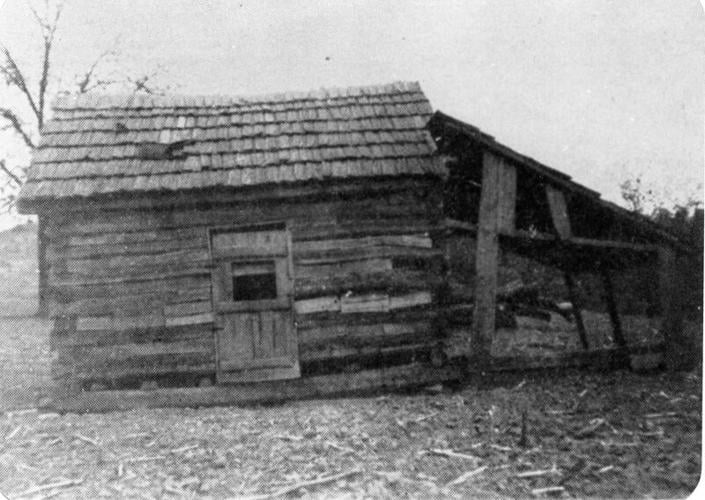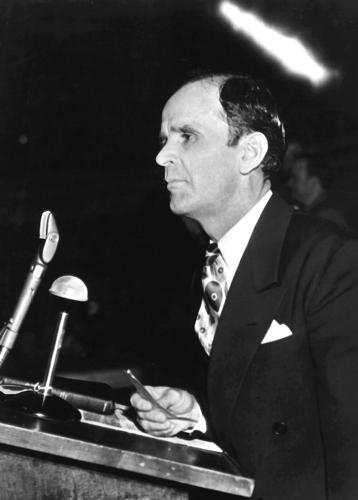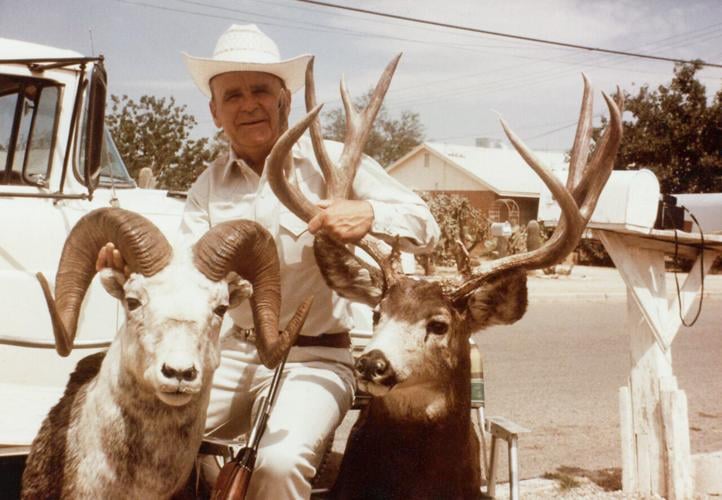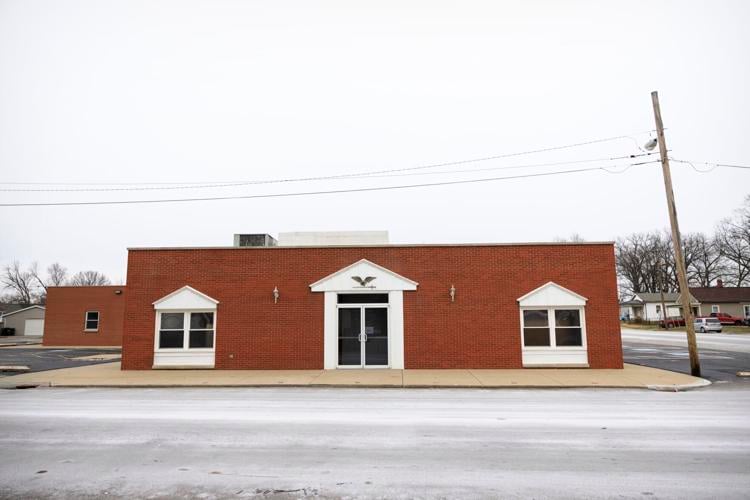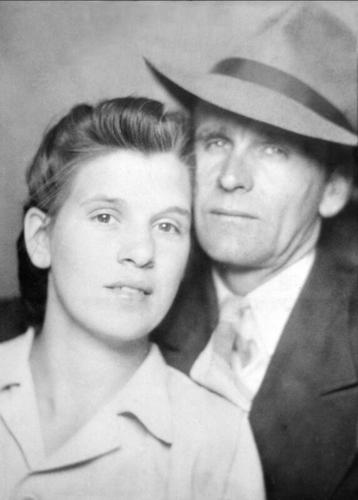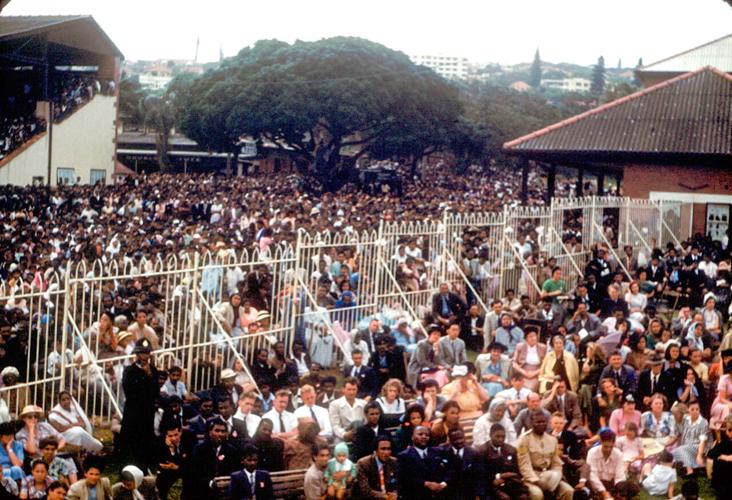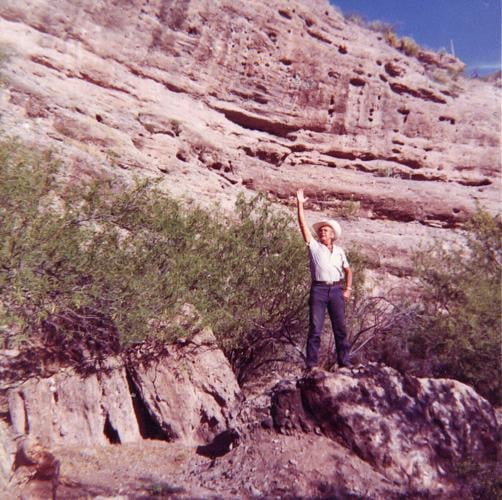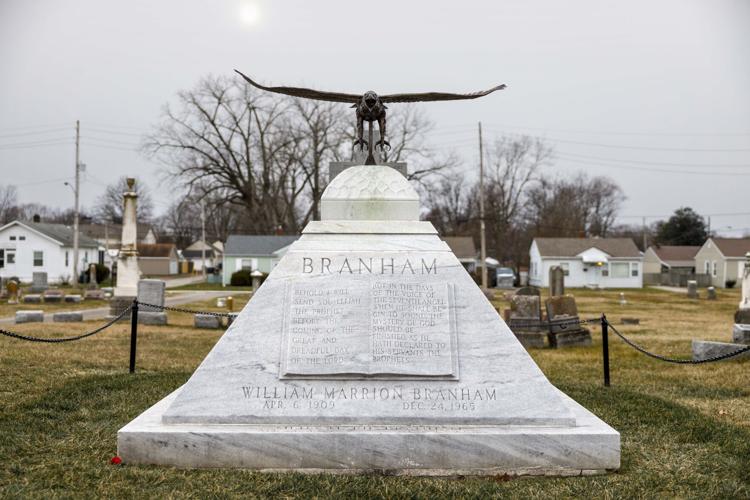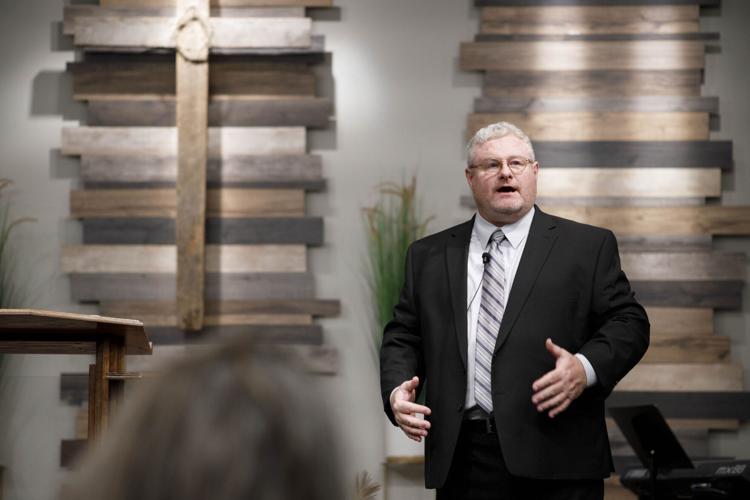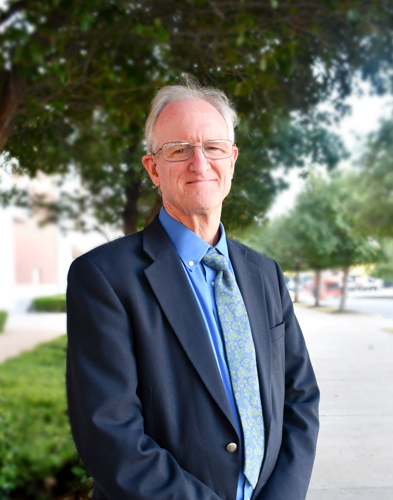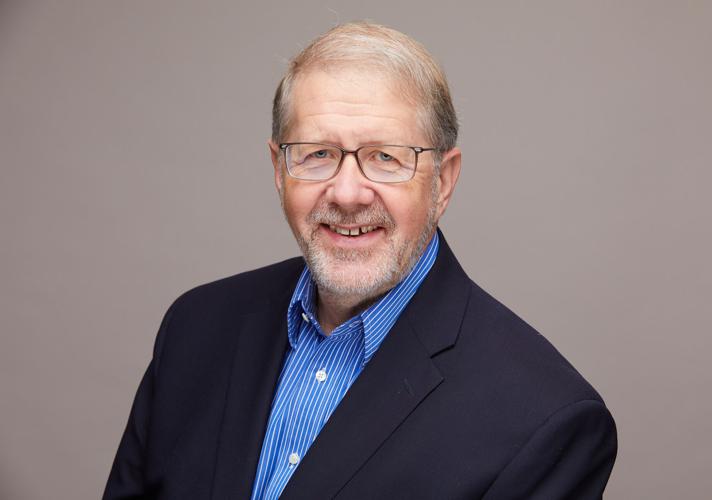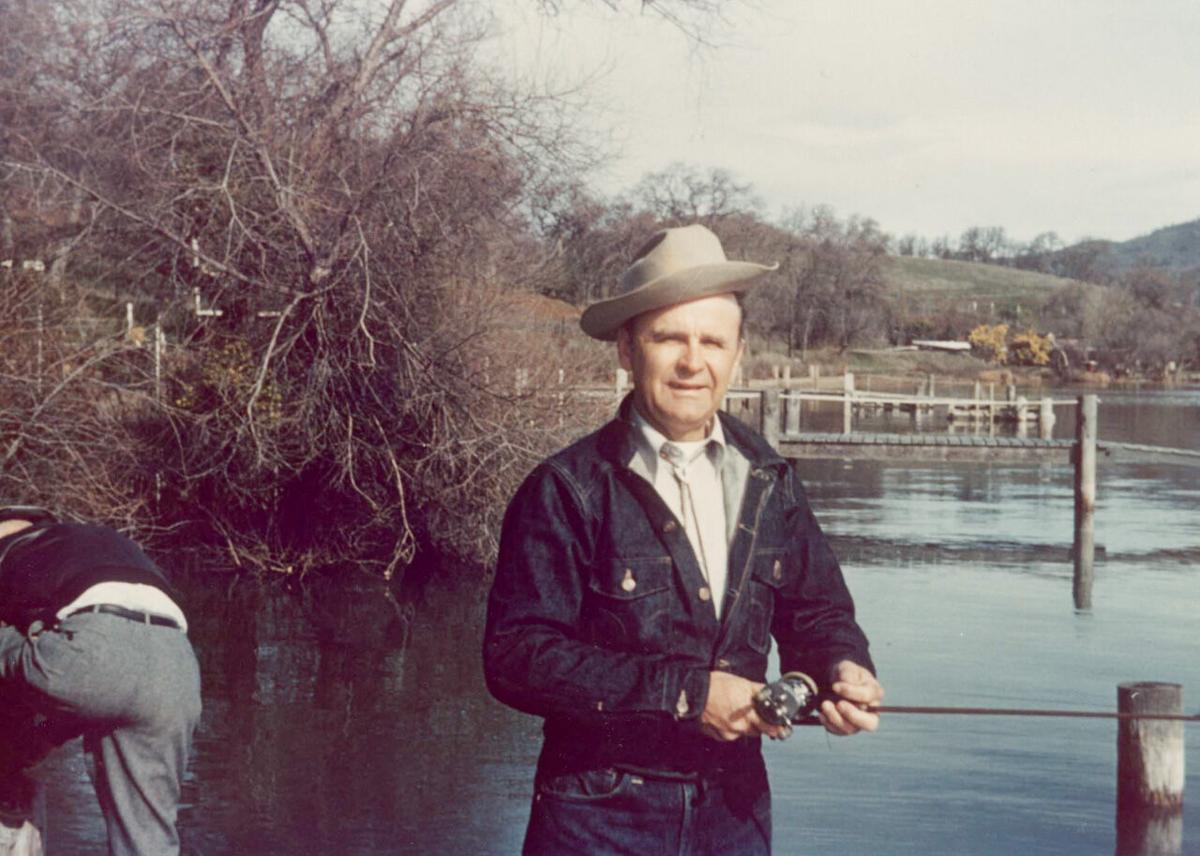Preacher William Branham told and retold his life story over decades, drawing in followers with tales of a backwoods childhood touched by supernatural occurrences.

Voice of God Recordings says this was Rev. William Branham's birthplace in Burkesville, Kentucky.
“I was borned up here in Cumberland County, Kentucky, in a little log cabin,” he said during a 1951 sermon in Jeffersonville, Indiana. “A little old window (was) in the side of the hut. After I was borned, a light came into that window, settled down where I was. It’s been with me from that day to this.”
This first appearance of a pillar of fire was one of many visions, prophecies and signs that continued throughout Branham’s life, he recounted in his sermons. These are what followers say helped “vindicate” his status as God’s prophet — the Elijah figure anticipated in Malachi 4:5.
Although Branham died in 1965, one estimate from a nonprofit called Voice of God Recordings says millions of people worldwide still follow his teachings. The religious sect is known as “The Message of the Hour,” or simply, “The Message.” It has spread in part through the more than 1,200 recordings of sermons by Branham.

A light appears above Rev. William Branham's head as his photo is taken during a debate with a skeptic in Houston, Texas, in 1950. Message followers believe the light was a supernatural being from the Holy Spirit, vindicating Branham's ministry and healing powers. They call the light the "Pillar of Fire."
They are all available online through Voice of God Recordings and the nonprofit's searchable app called The Table.
In sermons, books and his movement’s periodical, Voice of Healing, Branham portrayed himself as a poor, uneducated outdoorsman who humbly accepted God’s call to deliver a message.
When Aaron Dueñas was a child, Branham’s story mesmerized him, said Dueñas, 30, who left his Tucson Message congregation in 2022.
“William Branham's life story is extremely idolized,” Dueñas said. “This is common throughout The Message. (In) many churches his life story is … what grips people into The Message. It's what converts them in a way, all the emotion of it.”

Rev. William Branham with Dall sheep and mule deer trophies in Tucson, Arizona. The deer is "Big Jim," shot during the hunting trip in Colorado when followers believe he spoke a storm away, according to Voice of God Recordings. Branham was an avid hunter and outdoorsman.
'You are this prophet'
Branham grew up in a non-religious household, but he said he converted to Christianity just past the age of 20.
“After my conversion, which took place in a little shed behind our house, I took up affiliation with a phase of the Baptist church and became a local elder, being ordained by Dr. Roy Davis of Jeffersonville,” Branham wrote in a 1948 copy of Voice of Healing.

The Branham Tabernacle at 804 Penn Street in Jeffersonville, Ind. is pictured on Jan. 14, 2024. The church used to be pastored by Roy E. Davis, but the building burned down in early 1933. Davis left the state and gave Branham his congregation. Branham rebuilt the church, laying the first cornerstone later in 1933 and officially naming the building the Branham Tabernacle, according to the Branham Tabernacle website. Critics dispute that date.
Davis was a notable mentor: Before he ordained Branham, Davis had already gone to prison for financial crimes and become an enthusiastic member of the Ku Klux Klan. Later, Davis committed more crimes and became the top leader, or “imperial wizard” of the Original Knights of the Ku Klux Klan.
Branham spun his ordination into success, building up a church that he named after himself — the Branham Tabernacle in Jeffersonville, across the Ohio River from Louisville.
Branham told his life story so many different ways that it’s unclear what is true, said John Collins, a former member of the Branham Tabernacle.
After leaving The Message in 2012, Collins has spent years researching the sect and wrote a book called “Preacher Behind the White Hoods: A Critical Examination of William Branham and His Message.” Collins concluded that the preacher put on “stage personas" that varied with his audience. Even his birth date is unclear.
“The birth year that has been adopted by the latest version of William Branham’s stage persona, was that he was born in 1909,” Collins said. “And it was spiritually significant that he be born in 1909.

Weaver
“Yet he also used the year 1907 in some versions of his stage persona. And those were tied to a different spiritual event. And he used the year 1908 on government documents.”
Douglas Weaver, chair of the Department of Religion at Baylor University, said he doesn’t think the inconsistencies in Branham’s stories necessarily mean he was acting nefariously. As Branham’s popularity grew, Weaver said, he believes Branham “reinterpreted his life” to make it sound grander than it was.
“I think he had people around him telling him who he was," Weaver said. "And that they told him, ‘You are this prophet.’”
“I think he came to believe it about himself.”
A plunge into depression
Branham married Hope Brumbach in 1934, and they had two children, including one, known as Billy Paul, who was a leader in the sect until he died in 2023. Both Branham’s wife and his daughter, Sharon Rose, died in subsequent years., and Branham said he plunged into depression, attempting suicide at least once.
He struggled with his mental health episodically throughout his life. Branham described himself as “neurotic” suffering periods of desperate anxiety.

Rev. William Branham and his wife Meda Branham in the late 1940s.
Branham remarried in 1941, to a woman named Meda Broy, and the couple had three children: Rebekah, Sarah and Joseph, who remains a leader in the sect today, considered a prophet by some.
After World War II, William Branham burst into public attention as leader of a new wave of healing revivals.
“He had a very influential ministry because of the supernatural nature of it,” Voice of God Recordings spokesperson Jeremy Evans said of Branham.
It started in May 1946, when Branham prayed for the sick child of a minister in St. Louis and the girl was healed, according to “The Healer-Prophet,” Weaver’s book about Branham’s life. Branham returned to St. Louis in June and held a 12-day meeting where he preached and prayed for the sick. The revival had begun.
After that, Branham started receiving invitations for revival meetings, and his reputation for having the gift of divine healing grew, Weaver wrote. During a visit to Vandalia, Illinois in June 1947, 4,000 sick people traveled to the small town of 5,800 because they wanted to be healed by Branham. What followed was a “spiritual explosion."
More faith healers emerged and made converts by healing people, telling them stories of their pasts and futures, and performing other miracles.

A large crowd gathers to hear Branham preach at Greyville Race Track in Durban, South Africa, according to Voice of God Recordings.
“Branham’s the guy who started it. Oral Roberts was a close second behind him,” said Rod Bergen, a former Message follower who has written an upcoming book on Branham’s ministry. “Then you’ve got all these people copying them. A.A. Allen. Tommy Hicks. T.L. Osborn.”
Branham’s popularity surged and spread around the world as he toured from Norway to India to South Africa. But doubts about Branham’s healing powers quickly surfaced. Canadian newspapers questioned whether some of his healings really succeeded, and whether he had actually raised a person from the dead.
Branham persisted in claiming supernatural powers.
“I’m just your brother, by the grace of God, but when the Angel of the Lord moves down, it becomes, then a Voice of God to you,” he said in a 1951 sermon. “I am God’s voice to you.”
Breaking with churches
The post-War revival peaked in 1952 when there were at least 49 active evangelists featured in the Voice of Healing magazine, Weaver wrote. But by 1958 the “glory days” of the healing revival were over.

Bergen
Pentecostal churches that once supported the revival started backing off when they realized how big the offerings were at the tent meetings, Bergen said.
“At some point in time, they realized these guys were siphoning off all the money,” he explained. “ Basically, the churches stopped supporting them, and so the thing ended up dying off.”
From the late 1950s to 1965, Branham focused on developing new doctrine based on prophetic “revelations” he received from God, Weaver wrote.
Branham preached that hell was not eternal, that denominations were “the mark of the beast” and that Eve had sex with the serpent in the Garden of Eden — all unpopular doctrines that alienated Branham from Pentecostal ministers. But a group of loyal followers accepted them as truth.
Some followers began to see even more in Branham — a Messiah, or “God tabernacled in flesh” as some followers described it. A “deity cult” formed among some close to Branham, Collins said.
Branham acknowledged in a 1961 sermon that he had heard of followers who baptized believers in his own name.
“I got all kinds of letters that’s come in the last few days, and calls from different places, saying that I was Christ,” Branham said. “Brethren, that is a horrible, disgraceful, ungodly lie of the devil!”

Rev. William Branham at Sunset Mountain in Arizona.
Signs and prophecies
Branham’s later ministry was also filled with signs and visions he said were from God, including a series of prophecies Branham began touting in 1956 that he said originally came to him in 1933.
One of the common ones, which he referenced in 12 sermons between 1956 and 1963, was that cars would become shaped like eggs and driven without a steering wheel.
“In the '50s, (Branham) preached, he saw the vision in the '30s of a driverless car. Can you imagine?” Evans said. “And sure enough, here we are, and we have the car.”
Branham claimed in 1959 to have received a mysterious new gift from God that allowed him to speak things into existence. He said he used the gift to resurrect a small fish, calm a storm and create three squirrels on a hunting trip, among other miracles.

The halo-shaped cloud that appeared in the sky above Arizona on Feb. 28, 1963. Message believers regard the cloud as a supernatural sign from God. The cloud was the result of a missile launch at Vandenberg Air Force Base in California, though people didn’t know that then.
Perhaps the most famous sign that came to Branham was related to a halo-shaped cloud that appeared in the sky above Arizona on Feb. 28, 1963. Branham told various versions of what he saw and when, Collins said. But the gist of it was that seven angels came down from the cloud, and he received the secret of the Seven Seals from the Book of Revelation.
He went on to discuss these secrets in a series of sermons later in 1963.
“William Branham viewed his revelation of the seven seals as the pinnacle of his ministry and his ultimate purpose as a prophet,” former Message pastor Charles Paisley wrote in a forthcoming book, “Come Out of Her My People.” After this revelation, he wrote, “The followers of The Message are in a state of unending preparation for the rapture.”
This circular cloud, by the way, was real: It appeared very high in the sky above Arizona on Feb. 28, 1963, and was the result of a missile launch at Vandenberg Air Force Base in California, though people didn’t know that then.
To this day, many Message congregations use the halo cloud as a symbol of their faith. And many followers treat Branham’s prophecies and visions as fulfilled.
“I don't have to prove these things because God vindicated it that he's telling the truth,” Evans said of Branham’s visions.

Photos of the late Rev. William Branham are displayed in the lobby of Voice of God Recordings, a nonprofit that distributes the recorded and written sermons of Branham around the world, in Jeffersonville, Ind. on Jan. 15, 2024.
“All his visions have come to pass,” said Luis Aguilar, associate pastor of Jericho Tabernacle in Phoenix. “We believe William Branham is God’s prophet.”
Branham predicted the world would end in an atomic apocalypse with the U.S. as “one smoldering, burnt-over place” by 1977. Some believers point out that Branham used the word “predict” not “prophesize,” so those words were not meant to be infallible.
Branham was driving from his new hometown, Tucson, where he moved in January 1963, to his old hometown, Jeffersonville, in December 1965 when his car crashed in Texas. Followers were shaken.

The late Rev. William Branham's grave is pictured in Jeffersonville, Ind. Jan. 14, 2024. He died in 1965. Millions of people around the world still follow Branham and his teachings to this day. They believe he was a prophet. Some visit his grave on Easter each year to see if he will be resurrected to carry out unfulfilled prophecies.
Enduring legacy
That would not be the end of his influence, though. From 1947 forward, almost all of Branham’s sermons were recorded and saved. Voice of God Recordings has made the more than 1,200 recorded sermons available online and distributes them globally.
Branham’s legacy also lives on through “the continued allegiance of his disciples in various feuding groups,” Weaver wrote.
Bergen said the movement has “at least six or seven offshoots, and honestly, there might be more.”
“All these guys claim the mantle of Elijah,” Bergen said of the leaders of these groups.

Jeremy Evans, spokesperson for the nonprofit Voice of God Recordings, pulls out a tape of a William Branham sermon that is displayed in a recording studio in the nonprofit’s office and production facility Jan. 15, 2024, in Jeffersonville, Ind. Voice of God Recordings has translated some of the more than 1,200 sermons into 70 different languages and is working on translating all of them into both written and audio form.
The central sect is led by Joseph Branham, who is president of Voice of God Recordings. Some congregations revere Joseph as a prophet, thanks in part to his father wishing aloud that he would become one.
“I have always discouraged the people saying that I am a prophet, as I am just a Christian trying to serve the Lord just like them,” Joseph Branham said in an email. He said his father’s ministry is unique because it brings people back to “the Bible exactly as it is written,” and he wants to continue spreading that message.
“There is a wide range of beliefs found in the churches and amongst individuals that claim to follow Brother Branham’s teachings,” Joseph Branham said. “Even though some beliefs are opposite of what Brother Branham taught, we have never tried to correct any church or individual of their doctrinal beliefs.”

Paul LaFontaine, pastor of Literal Life church in Michigan, preaches during a Wednesday night service Nov. 1, 2023.
Paul LaFontaine, pastor of Literal Life church in Michigan, said the Bible is his “absolute,” not Branham's word. Branham acknowledged that he was human and that his followers should check everything he said against the Bible.
“Prophets make mistakes,” LaFontaine said.
That’s why LaFontaine believes it’s important to have a pastor interpret Branham’s sermons within the context of the Biblical scriptures he was referring to. But Evans said Branham needs no interpretation.
“Don’t just take one sentence out of 1,217 recordings. Listen to the whole tape or listen to the whole segment at least and get the context there,” Evans said. “There’s no one that can tell you about The Message better than Brother Branham.”
About this series
Lee Enterprises investigative team and the Arizona Daily Star interviewed more than 50 former and current Message followers, experts and religious leaders for “Twisted Message.” The series examines the lack of accountability in a Christian religious sect called “The Message.” Some groups that claim to follow the faith have become controlling or destructive, including a Tucson church accused of being a “cult,” an Arizona trailer park commune that physically and sexually abused children in the 1960s and churches across the U.S. that allegedly treat women as “second-class citizens.” The year-long investigation is the first news-media account of The Message and its global influence.

Joseph Branham
Leaders influenced by the late Rev. William Branham have overseen controlling religious groups worldwide, including a trailer park commune that abused children in the 1960s and a Tucson church that former members accuse of being a "cult."


